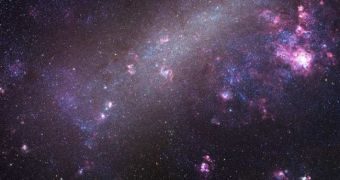They have been known since the time of the famous explorer that made the first round of the world, Fernando Magellan (in the 16th century). The two dwarf galaxies, the Large and Small Magellanic Clouds, which were believed to be Milky Way's longtime companions are in fact just relative new arrivers to our neighborhood that are just passing by, as found by a new research led by Gurtina Besla of the Harvard-Smithsonian Center for Astrophysics in Massachusetts.
The new study remakes previous theories based on long-lasting interactions between the Milky Way and the two galactic clouds.
Some researchers believed that a blazing hydrogen trail expanding from the Clouds, called the Magellanic Stream, emerged linked to tidal interactions between the Clouds and the Milky Way, while others put it in the hydrogen gas being stripped from the Clouds by gas pressure as they met the gas halo surrounding our galaxy. Both theories are falling now.
At about 160,000 light-years from Earth, the Large Magellanic Cloud (LMC) has 5 % of the diameter of our galaxy and contains 10 % as many stars. The Small Magellanic Cloud is located 200,000 light-years from Earth and is 1 % of the Milky Way. When the astronomers made in 2007 the most detailed measurements yet of the 3-D speeds of the Magellanic Clouds, they discovered they are moving through space twice as fast as previously believed.
When Besla's team put this into computer models, it appeared that both galaxies possessed extremely parabolic orbits, having entered our neighborhood for the first time between 1 and 3 billion years ago.
"The problem is [the LMC] is moving at a velocity that would correspond to a parabolic orbit. It's just moving too fast. If there were no other effects involved, it would just slingshot away. Friction forces from the Milky Way's gas halo and an observed loss of mass in the form of the Magellanic Stream slow down the galaxies." said Besla.
With such elongated orbits, the Magellanic galaxies are unlikely to return toward the Milky Way soon.
"It will go out really far before it comes back around again and it will take an extremely long time ... on the order of like 8 billion years and beyond," Besla told SPACE.com.
"Theories put forward to explain the Magellanic Stream involved a lengthy interaction between the Clouds and our galaxy. An alternative mechanism must be at work. As stars form they start losing a lot of material through stellar winds and they also explode and that blows out material. It's possible some of that material gets puffed out and then other effects like 'ram pressure' and tidal effects can then remove this really loosely bound stuff." said Besla.
Tidal effects between large space objects (like the moon and Earth, or two galaxies) make one side of an object to be tugged more than the opposite side, stretching it.
The LMC and SMC have functioned as laboratories to see how stars evolve. While our galaxy, the Milky Way, is continually churning out stars, the Magellanic galaxies have experienced several bursts of star genesis followed by quiet intervals. "Those bursts had typically been linked to multiple passages around the Milky Way. Now that doesn't fly." said Besla.

 14 DAY TRIAL //
14 DAY TRIAL //